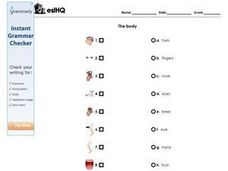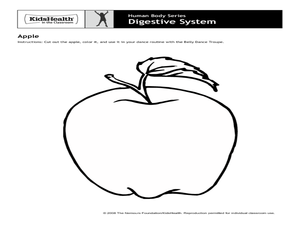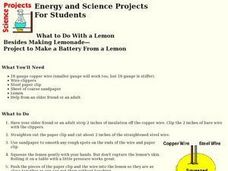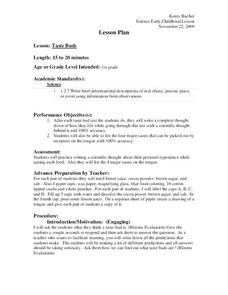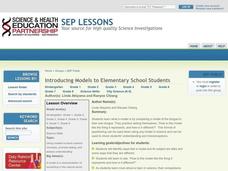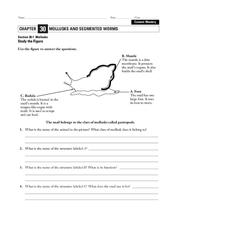Curated OER
Is It Safe To Go In?
Students examine acceptable levels of toxins in swimming areas. Working in groups of four, students dilute a salt or sugar solution to 1 part per 1,000,000 (ppm) solution. Students taste test their diluted liquids and record at which...
Curated OER
ESL The Body Word/Picture Matching Worksheet
In this ESL body parts instructional activity, students examine 10 small pictures of body parts. They match the pictures to the words that name them such as toes, fingers, nose, and eyes.
Curated OER
What Happens to the Food You Eat? The Digestive System
Young scholars observe a video displaying body parts and functions of the digestive system. They make drawings of the digestive system from their observations. They act out a short play involving body parts.
Curated OER
Human Body Series - Digestive System
With articles entitled, "What's Puke?" and "What is a Fart?" this digestive system lesson is sure to be a gas! Elementary anatomists do a belly dance to illustrate how food moves through the digestive system and then design a board game...
Curated OER
Learning About Animals' Bodies
Students research different animals (mammals, reptiles, amphibians, insects, birds, fish) and create books, murals, dioramas, puppets, and sculptures to illustrate the necessity of various body parts for overall survival. In this animal...
Curated OER
Make a Battery From a Lemon
Fifth graders construct a voltaic battery. They change chemical energy into electrical energy by inserting copper wire into a lemon. They discover the tingle of the wire on their tongue is due to the movement of electrons.
Curated OER
Taste Buds
First graders taste a variety of items and record a full sentence about the way they taste. In this taste buds lesson, 1st graders predict and then taste various items. Students draw a picture of the tongue and show the part that...
Curated OER
Family Traits
Students investigate the study of pedigree designs and human genetics. They construct the pedigree representing two, three, or four generations. They investigate their family members' traits for ear lobe attachment, tongue rolling,...
Curated OER
How Plants Spice Up Our Lives
Third graders study plants. In this biology lesson plan, 3rd graders label and identify parts of plants, identify spices obtained from plants, and determine what part of a plant a spice comes from by using taste, touch, smell and sight.
Curated OER
Physical vs. Chemical Changes
In this chemical reactions worksheet, students read about the differences between physical and chemical changes in substances. Then students identify situations as either an example of physical or chemical change. Students learn how to...
Curated OER
Reptiles
In this reptiles worksheet, learners identify and label the different parts of reptiles. They complete 10 short answer questions after reading the information provided in the worksheet.
Curated OER
The Senses: Taste
In this biology learning exercise, students label the portions of the tongue that are responsible for sweet, sour, bitter, and salty tastes. They complete a chart telling which tastes they like and dislike.
Curated OER
Introducing Models to Elementary School Students
Young scholars explore the concept of models. In this model lesson, students examine 3-dimensional models of various objects and body parts to better understand the natural world.
Curated OER
All About Me: My Senses
Students explore the world around them and identify their five senses and the parts of their bodies that are associated with each sense.
Curated OER
Beautiful Bovine
Students compare and contrast a human body to a cow. Using a diagram, they label and identify the functions of the cow's numerous parts. In groups, they create a Venn Diagram to compare the various types of cows with one another. They...
Curated OER
Game 3-1
In this vocabulary worksheet, students answer the question, "What is it?" to identify the object in each picture. Each picture features a part of the body. The worksheet is intended for use with English language learners.
Curated OER
Humans
In this anatomy worksheet, students read a passage about the different parts of the human body. They then answer the 10 questions on the page.
Curated OER
Inventions, Puppets, and Commercials
Fourth graders invent a product and present it to the class. In this inventions lesson plan, 4th graders get into groups and have to come up with an invention. They also advertise by writing a television commercial with a script and part...
Curated OER
Mollusks
For this mollusks worksheet, learners use an illustration of a snail to complete 4 short answer questions about the structure and function of the parts of gastropods.
Curated OER
Robots
Students play the parts of robots and their controllers. For this robot lesson plan, students learn about robots, and use verbal commands to simulate how a robot would command to it's controller.
Curated OER
Baleen Whales vs. Toothed Whales
Second graders review mammal characteristics and study two types of whales. For this mammal study lesson, 2nd graders discuss mammals and define their five characteristics. Students complete a whale worksheet and define differences...
Curated OER
My Five Senses
Students investigate the five senses. In this senses lesson, students explore the nervous system. Students examine how the body receives information through the five senses.
Curated OER
Matching Flowers With Their Pollinators
Young scholars match flowers to pollinators and construct models of
flowers to demonstrate why different kinds of flowers need different kinds of
pollinators. They use their flower models and the "Scientific Method Format" included in...
Roland Park Country School
Butterfly or Moth?
What is the main difference between a moth and a butterfly? Butterflies have club-shaped antennae, while moths have a feather-like antennae. But what else differentiates these beautiful insects? The presentation in the resource provides...



